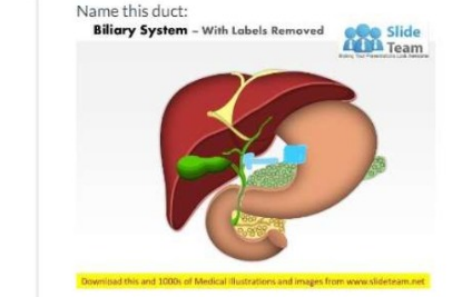Name this duct:

Pancreatic duct
Common bile duct
Common hepatic duct
Cystic duct
The Correct Answer is C
A. Pancreatic duct: The pancreatic duct (duct of Wirsung) conveys pancreatic enzymes from the pancreas to the duodenum and typically joins the bile duct at the hepatopancreatic ampulla.
B. Common bile duct: The common bile duct is formed by the union of the common hepatic duct and cystic duct and carries bile from the liver/gallbladder to the duodenum.
C. Common hepatic duct: The common hepatic duct drains bile from the right and left hepatic ducts of the liver and joins the cystic duct to form the common bile duct.
D. Cystic duct: The cystic duct connects the gallbladder to the common bile duct and allows bile to flow into and out of the gallbladder for storage and release.
Nursing Test Bank
Naxlex Comprehensive Predictor Exams
Related Questions
Correct Answer is D
Explanation
A. The exocrine function involves hormone release, while the endocrine function involves the secretion of buffers and enzymes.:this reverses the roles; exocrine does enzymes/buffers, endocrine does hormones.
B. The endocrine function involves the secretion of digestive enzymes, while the exocrine function involves hormone release.: reversed roles.
C. The exocrine function involves the release of insulin and glucagon, while the endocrine function involves hormone release.: insulin and glucagon are endocrine products, not exocrine.
D. The endocrine function involves the release of insulin and glucagon, while the exocrine function involves the secretion of digestive enzymes and buffers.: the pancreas’ islet cells secrete insulin/glucagon (endocrine) and acinar/bicarbonate secretions go to the duodenum (exocrine).
Correct Answer is C
Explanation
A. It depends on the complete lack of surface tension on the alveolar wall:Alveoli have surface tension; pulmonary surfactant reduces surface tension but does not eliminate it. Quiet expiration does not require an absence of surface tension.
B. It is driven by increased blood CO₂ levels:Elevated CO₂ increases the drive to breathe (affects ventilation rate), but quiet expiration itself is notactively driven by CO₂ -it is passive.
C. It is a passive process that depends on the relaxation of inspiratory muscles:Quiet expiration occurs when the diaphragm and external intercostals relax and elastic recoil of the lungs and chest wall returns air to atmosphere.
D. It requires contraction of abdominal wall muscles:Abdominal muscle contraction is used for forced expiration (e.g., coughing or heavy exercise), not normal quiet expiration.
Whether you are a student looking to ace your exams or a practicing nurse seeking to enhance your expertise , our nursing education contents will empower you with the confidence and competence to make a difference in the lives of patients and become a respected leader in the healthcare field.
Visit Naxlex, invest in your future and unlock endless possibilities with our unparalleled nursing education contents today
Report Wrong Answer on the Current Question
Do you disagree with the answer? If yes, what is your expected answer? Explain.
Kindly be descriptive with the issue you are facing.
